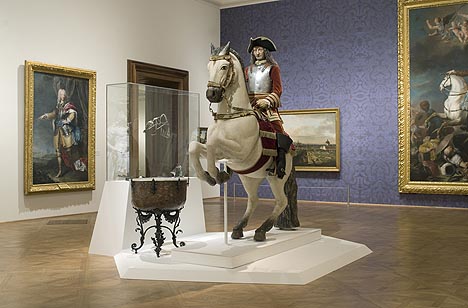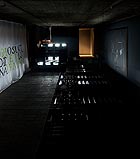
translated and summarized by: Liz Wollner-Grandville,
English summary March 15 - 21
Unteres Belvedere
Prince Eugene – General, Philosopher, and Art Lover
11.02.10 bis 06.06.10
The Prince’s glorious return to the Belvedere
Two hundred and ninety years after the start of the construction of the Belvedere, Prince Eugene of Savoy returned to this perhaps most important location of his reign - and is offered a posthumous homage. But can an exhibition meet the standards of this splendid military leader, this meticulous collector and visionary control freak, who showed equal interest in Tripolitan sheep, Gottfried Wilhelm Leibniz and new types of flintlock muskets? The Bibliotheca Eugeniana encompassed 15.000 volumes, to which 178 paintings, countless graphics, and cultural goods were added, and which were mainly kept in the collections of the Belvedere, the Albertina, the Art History Museum and the Austrian National Library. Marie Sophie von Plessen has a passion for cultural historic topics and organized the remarkable exhibition on Prince Eugene.
The exhibition is divided into six parts. Four of them deal with his fascination of building, of military leadership, of collecting and as a patron of art and are presented in the Lower Belvedere. Autographs and Salomon Kleiner’s fine Belvedere etchings accompany the visitor through the rooms, and the quotations partly convey a refreshing eternalness: e.g. as the one written by Prince Eugen when he went to war in 1701. “Should one leave Milan and Brussels to France without a blow of the sword? In that case, Germany must yield itself to French sovereignty - as not even the worst war can be the cause of anything more abominable”.
Peter Baldinger’s arrangements are pleasantly restrained and offer the diverse artefacts sufficient space. Von Plessen and Baldinger present the paintings in a “Petersburg Hanging” style, and sometimes let an individual work stand out alone. And there are also fine interruptions: a 230-cm marble apotheosis of the Prince in a passageway or the conjuncture of two pen and ink drawings. Above Cornelis Troost’s work, depicting the Prince in Madame Traese’s brothel in Amsterdam, is Pieter von den Berge’s drawing, showing the Prince as an art connoisseur during his visit with art collector Zomer in Amsterdam. Remarkable is also the wax bust of the sole heiress, Princess Victoria of Savoy, who, in no time at all, exchanged her uncle’s riches for cash.
The second part of the exhibition is presented at the Orangerie and boasts with a reconstruction of the legendary painting-room; some of the original paintings – mainly loans from the Galleria Sabauda in Turin – are hung amidst Salomon Kleiner’s and Johann Jacob Graessmann’s artwork. Adjacent are some of the monumental works from the Bibliotheca Eugeniana. One also finds Giovanni Boccaccio’s Decameron among the works of the Gothic Bible Moralisée and the hagiographies of Jacobus de Voragine. It once again becomes clear that von Plessen only selected top quality and involved it in a prolific exchange of ideas. It is this soothing, and at the same time inspiring, melange of these diverse forms of presentation that bestows the 280 objects their powerful performance and creates an exhibition, which can only take place at the Belvedere.
By Harald Krämer
Unteres Belvedere
1030 Vienna, Rennweg 6
Tel: +43 1 79557 – 134
Fax: +43 1 79557 – 134
www.blvedere.at
Opening hours: Daily 10 a.m. to 6 p.m., Wednesdays 10 a.m. to 9 p.m.
MUMOK Museum moderner Kunst
Changing Channels – Art and Television 1963 – 1987
05.03.10 – 06.06.10
Conquest of the third dimension
The extensive MUMOK exhibition “Changing Channels” presents 120 audiovisual works dealing with art and television. Not the history of the mass medium, but an artistic debate concerning television between 1963 and 1987 is the main focus of the exhibition.
The “Video-Synthesizer”, a sculpture made of television sets by Nam June Paik and Shuya Abe, (which at that time was considered to be high-tech), was capable of changing any TV signal into an abstract painting - whereby the mass medium was transformed into an artistic element and used the screen as a canvas. This work, which was originally created in 1969 is an early example of the confrontation of the Fluxus Movement with TV-pictures.
These products, which aimed at influencing television with interventions and happenings, could easily fill the entire exhibit. From the 60’s to the mid 70’s these on-site-interventions played an important role. Ant Farm’s video “Media Burn” was made in 1975 and deals with an Independence Day performance. It shows a wall made of TV sets, and two “racing drivers” dashing into the wall with a Cadillac transformed into a racing car; ultimately the wall catches fire. In an introductory statement, Ant explains that this was meant to “cure his TV-addiction”. Numerous local TV-stations covered the story - thereby enabling Ant to achieve the desired transformation process of the mass medium, as well as attaining media attention.
Specific formats, which aimed at introducing new art movements to the audience, such as Land Art, are presented on level 7. Gerry Schum’s “TV Gallery” gave Richard Long, Robert Smithson, Jan Dibbets, and Walter de Maria the opportunity to contribute short features under the title “Land Art”. Shortly before broadcasting the series “Identifications”, the Süd West Funk channel requested Schum to prepare an accompanying commentary. Schum refused and argued that after all, “paintings would also not be used to make arbitrary statements at an art exhibition.” He savvied his contributions as gallery performances.
Andy Warhol’s entire “TV Work” is presented in the MUMOK Factory - including the 30-minute series “Fashion”, in which he let the protagonists of fashion (models, designers, photographers) have their say. “Fashion” was broadcast in 1979 and 1980. And he created “Fifteen Minutes!” which was presented on MTV in the years 1985 to 1987. They were based on his famous quote that “everyone can be famous for 15 minutes”.
Austrian positions include works by Richard Kriesche, Valie Export and Peter Weibel. All in all, the Hercules-like achievement to deal with the classic medium television on such a broad scale, especially during a time in which new digital worlds emerge each day and TV-consumption is undergoing a huge change, is absolutely worthwhile. The tickets are valid for two visits to the exhibition: to allow everyone to “watch TV in peace”.
By Susanne Rohringer
MUMOK Museum moderner Kunst
1070 Vienna, Museumsquartier
Tel: +43 1 52 50 0
www.mumok.at
Opening hours: Tue – Sun 10 a.m. – 6 p.m., Thu 10 a.m. – 9 p.m.
Künstlerhaus Wien
Ute Müller, Christoph Meier, Nick Oberthaler – In Passing 10
19.02.10 until 31.03.10
Art as a conditional element of space
For years, the exhibition series In Passing at the Künstlerhaus Passage presented possibilities of how art responds to specific socio-geographic spaces and thereby utilizes the conditions of space. As an urban zone, which is perceived either consciously or subconsciously, the k/haus Passage mainly serves as a focus of attention for a non art-specific audience, whereby an interface between everyday situations and their artistic penetration evolves automatically by the displayed artwork.
Christoph Meier set up a stage-like installation made of black plastic pallets, which oscillates between a bar, a DJ-booth and a concert area and is used in all of these functions at a vernissage, midissage and finissage. Thereby the artist refers to the diverse ways this location can be used, and in which guests from the Flex or Fluc regularly get together for evening events.
Ute Müller’s painting adds to the transformation of space concepts, by changing a gray image with architectural lines in a dark gray setting into the seemingly black surroundings at nighttime. The artists pursue their focus on night scenarios with their group work black pages, in which different artists design a fanzine in black.
Nick Oberthaler refers to the light-flooded glass façade, which he decorated with a white curtain, respectively with muslin used in stage productions. Thereby the predominantly dark interior of the room is confronted with the outer space directly at its transition point to daylight. Oberthaler’s frequent use of Latin text is appliquéd on the curtain with an ode by the poet Catullus.
Points of reference to space and its potential of inside and outside, respectively private, semi-private and public, form the connection of the works of the artist-trio that repeatedly work together, this time concentrating on an interaction of light and user interface.
By Walter Seidl
Künstlerhaus Wien
1010 Vienna, Karlsplatz 5
Tel: +43 1 587 96 63
www.k-haus.at
Opening hours: Daily 10 a.m. – 6 p.m.
Galerie ArtPoint /KulturKontakt Austria
On cities, light and identity: Tonka Malekovic from Croatia, Dalibor Nikolic from Bosnia-Herzegovina and Velimir Zernovski from Macedonia
10.03.10 – 31.03.10
The combined view of individuals
This year’s first group exhibition at the Gallery Artpoint, showing works by the Croatian Tonka Malekovic, the Bosnian Dalibor Nikolic and the Macedonian Velimir Zernivoski, is divided into three separate areas, which in turn come together again in one venue, the city of Vienna.
Tonka Malekovic explores Vienna in her series “Analogue (City)”. “Underworld” videos showing underground stations, escalators and passageways are juxtaposed with winter images of the city. The sterile, often deserted and somewhat eerie atmosphere of the underground is set in contrast with the winter world up above, depicted on photographs shot with only one spotlight.
Dalibor Nikolic utilizes the sunlight as a light source for his projections on architectural details in the city. The number 08’32 describes the time sunlight needs to reach the earth: 8 minutes and 32 seconds. His selection of the projection surfaces mirrors his reference to architecture, especially to LeCorbusier.
The third room shows Velimir Zernivoski’s video “In the Third Picture” which was created in Vienna. The change he underwent during his stay is the projection surface for the steady self-reflection by the viewers, and is meant to stimulate rethinking one’s own role within the social development.
By Alexander Lass
Galerie ArtPoint / KulturKontakt Austria
1010 Vienna, Universitätsstrasse 5
Tel: +43 1 523 87 65 – 14
Fax: + 43 1 523 87 65 – 20
www.kulturkontakt.or.at
Opening hours: Mo – Fr: 2 p.m. – 6 p.m.
Mehr Texte von translated and summarized by: Liz Wollner-Grandville


 Teilen
Teilen





